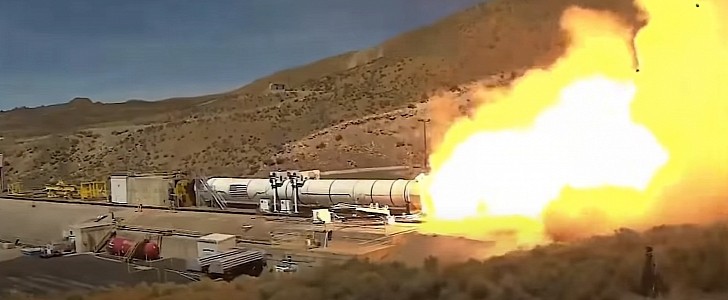The Space Launch System (SLS) is how NASA calls the rocket that will carry humans back to the Moon by the middle of the decade, and possibly even on to Mars in the more distant future. And at the core of the SLS are the “largest, most powerful boosters ever made.”
Two of them, accompanied by four RS-25 engines and the core stage, provide about 75 percent of the combined output of 8.8 million pounds of thrust during launch, about the same power 160,000 Corvette engines would develop working in sync. And below is a video showing just one of the boosters in action during a full-scale test conducted in Promontory, Utah, on September 2.
A single one is good for 3.5 million pounds of thrust, and you can literally feel every ounce of power as soon as the booster, sitting horizontally on a test pad, is lit up. Cameras on site to record the moment shake in unison, and you can almost feel the ground rumble all around.
The entire adventure lasts for just two minutes (the same amount of time the boosters will brun during the actual launch), but that was enough for space engineers to find out what they needed, including in terms of motor performance.
“The full-scale booster firing was conducted with new materials and processes that may be used for NASA’s Space Launch System (SLS) rocket boosters. NASA and Northrop Grumman, the SLS boosters lead contractor, will use data from the test to evaluate the motor’s performance using potential new materials and processes for Artemis missions beyond the initial Moon landing in 2024,” the space agency said.
The first official test flight of the SLS is scheduled for sometime next year. If all goes well then and during subsequent tests, we are to expect the rocket to launch the Orion spacecraft with crew on board to the Moon by 2024.
A single one is good for 3.5 million pounds of thrust, and you can literally feel every ounce of power as soon as the booster, sitting horizontally on a test pad, is lit up. Cameras on site to record the moment shake in unison, and you can almost feel the ground rumble all around.
The entire adventure lasts for just two minutes (the same amount of time the boosters will brun during the actual launch), but that was enough for space engineers to find out what they needed, including in terms of motor performance.
“The full-scale booster firing was conducted with new materials and processes that may be used for NASA’s Space Launch System (SLS) rocket boosters. NASA and Northrop Grumman, the SLS boosters lead contractor, will use data from the test to evaluate the motor’s performance using potential new materials and processes for Artemis missions beyond the initial Moon landing in 2024,” the space agency said.
The first official test flight of the SLS is scheduled for sometime next year. If all goes well then and during subsequent tests, we are to expect the rocket to launch the Orion spacecraft with crew on board to the Moon by 2024.







